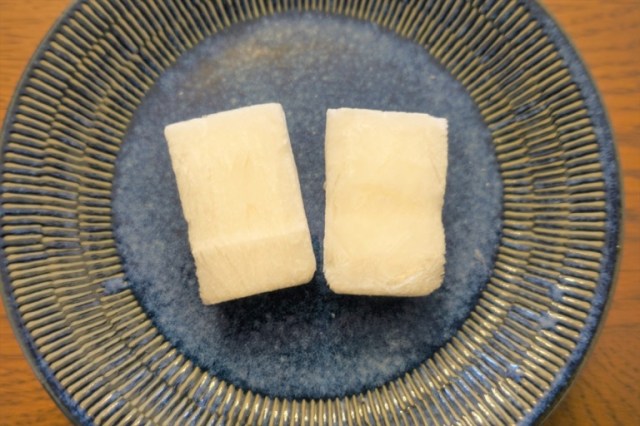
They started making korimochi in Nagano a long time ago, but you can still find and try it today.
Freeze-dried food sounds like a recent invention, the sort of thing only made possible and predicated by a combination of the modern era’s high technology and busy lifestyles. But in Japan, they’ve had freeze-dried food for over 600 years in the form of korimochi, or “ice mochi.”
People started making korimochi all the way back in the Kamakura period, (1185-1333). Since they didn’t have electric-powered freezers back in those days, the freezing temperatures had to come from nature itself, and korimochi was developed in the mountains of the Shinshu region, which corresponds to Nagano Prefecture in the Japan of today. Farmers in Shinshu made korimochi by forming thin rice cake sheets, soaking them in water, and cutting them into strips. They’d then hang the strips from the eaves of their homes in the cold alpine winter air for as long as two months, during which the mochi would freeze and dry.
▼ Korimochi
On one of our recent trips through Nagano, we came across packs of korimochi being sold in the Okuwa Michi no Eki roadside souvenir shop in the town of Okuwa. Made by Nagano-based Yamayo Food Industry, the 540-yen (US$4.10) pack contained 12 pieces of ice mochi, and we decided to buy it and try it out.
There is exactly one ingredient in korimochi: mochi rice. Taking a pair of the 4.5-centimeter (1.8-inch) pieces out of the bag for a closer look, they were light and completely dry to the touch, with a finely layered texture.
According to the packaging, there are two ways to eat korimochi. The first is just to eat it as-is, so that was what our reporter Haruka Takagi did for the first part of the taste test.
The texture is crisp, but very different from senbei (Japanese rice crackers). Senbei are grilled or fried, both cooking processes that create air pockets here and there. Korimochi, on the other hand, has a consistently solid feel, similar to another old-school Japanese food, fu (dried wheat gluten). In terms of texture, korimochi couldn’t be farther from the soft and chewy feel of normal mochi.
As Haruka chewed and the korimochi crunched, though, the freeze-dried rice cake began to absorb moisture from her mouth, revealing the same sweet rice flavors beloved by all mochi fans. The disconnect between the flavor and the texture Haruka usually associates with it felt like her brain was momentarily malfunctioning, but once she recovered from the surprise the result was tasty and comforting.
Now it was time to move on to the second way to eat korimochi: mixing it with hot water.
The packaging didn’t say how much water to use, so Haruka tossed two pieces of korimochi in a cup and then poured in enough for them to start floating.
The packaging also recommended adding sugar or honey to make the korimoci into a sweet snack, and so Haruka stirred in a teaspoon and a half of sugar too. After a few more spoon swirls for good measure, the korimochi had dissolved enough to create a creamy cloudy mixture that looked a lot like okayu, Japanese rice porridge.
Again, though, the unique starchy sweetness of mochi shines through in the flavor, giving Haruka a warm and relaxing treat.
She’s also thinking that korimochi would work well with savory twists like ginger or chicken broth, so she’s glad she still has eight pieces left in the pack, even though, since this is one of Japan’s original freeze-dried foods, there’s no need to rush and eat it all right away.
Related: Michi no Eki Okuwa
Photos ©SoraNews24
● Want to hear about SoraNews24’s latest articles as soon as they’re published? Follow us on Facebook and Twitter!
[ Read in Japanese ]

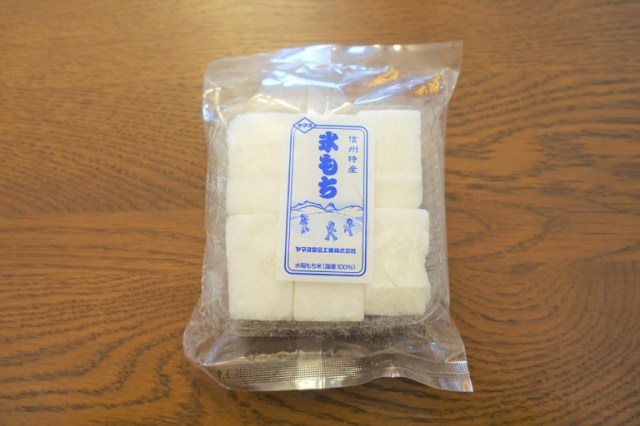
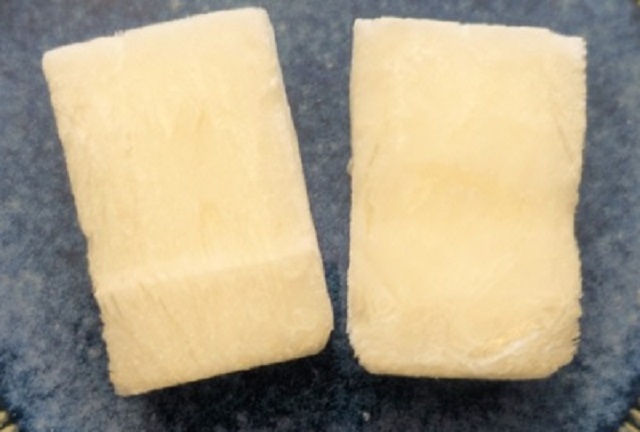
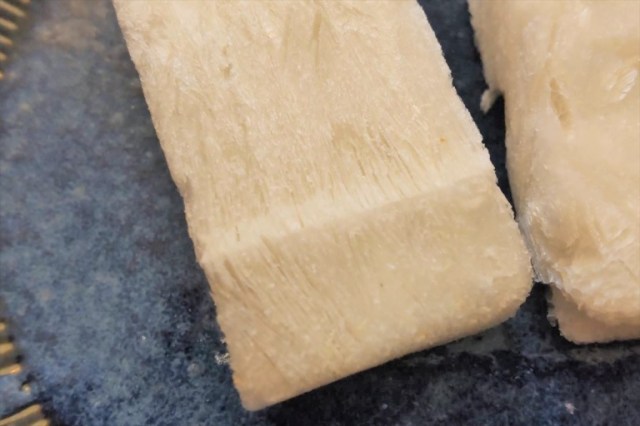



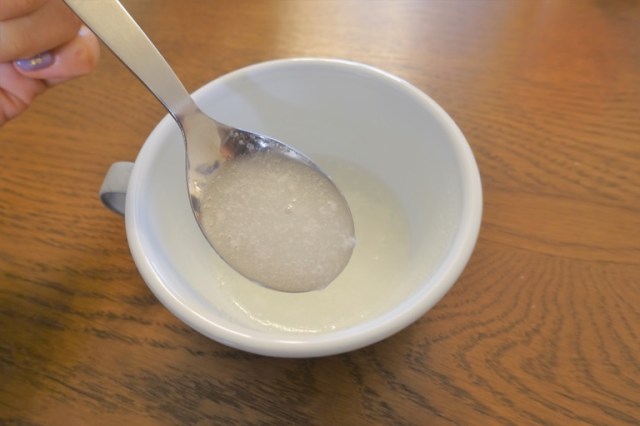

 Vending machine noodle ice cream: A retro icon in Japan brings joy to a new generation
Vending machine noodle ice cream: A retro icon in Japan brings joy to a new generation Making a traditional Japanese dessert from “heaven grass”【Photos】
Making a traditional Japanese dessert from “heaven grass”【Photos】 Sweet mochi beer? Yamanashi sweets maker teams up with craft brewer for Kuromitsu Black
Sweet mochi beer? Yamanashi sweets maker teams up with craft brewer for Kuromitsu Black Japan’s hardest rice crackers, snacks of the shinobi, go soft, so do they have a reason to exist?
Japan’s hardest rice crackers, snacks of the shinobi, go soft, so do they have a reason to exist? Sweet potato sweets season arrives at convenience store Family Mart, so let’s go taste-test-crazy
Sweet potato sweets season arrives at convenience store Family Mart, so let’s go taste-test-crazy Station of despair: What to do if you get stuck at the end of Tokyo’s Chuo Rapid Line
Station of despair: What to do if you get stuck at the end of Tokyo’s Chuo Rapid Line This downtown Tokyo cafe is like a time machine that takes you back 50 years into the past
This downtown Tokyo cafe is like a time machine that takes you back 50 years into the past Japanese government will check and judge new baby name pronunciations, presents guidelines
Japanese government will check and judge new baby name pronunciations, presents guidelines Totoro towels gently glow in the dark to set the Ghibli nighttime mood in your home【Photos】
Totoro towels gently glow in the dark to set the Ghibli nighttime mood in your home【Photos】 Studio Ghibli tea blends contain ingredients inspired by My Neighbour Totoro
Studio Ghibli tea blends contain ingredients inspired by My Neighbour Totoro Major Japanese city is abolishing extracurricular activities at all of its middle schools
Major Japanese city is abolishing extracurricular activities at all of its middle schools Celebrating legal marriage days in Japan with budget-friendly photoshoots
Celebrating legal marriage days in Japan with budget-friendly photoshoots Japanese company develops classy heavy metal band frames for glasses
Japanese company develops classy heavy metal band frames for glasses Cup Noodle sells new squid fork with its instant ramen
Cup Noodle sells new squid fork with its instant ramen Japan now has fish-shaped soy sauce bottle hand cream
Japan now has fish-shaped soy sauce bottle hand cream One of Japan’s rarest sweets is a sell-out hit that looks and tastes like frost
One of Japan’s rarest sweets is a sell-out hit that looks and tastes like frost Studio Ghibli showcases traditional craftsmanship with new wallet range
Studio Ghibli showcases traditional craftsmanship with new wallet range Mysterious light-up rainy night-sound Totoro figure doesn’t actually show a scene from the anime
Mysterious light-up rainy night-sound Totoro figure doesn’t actually show a scene from the anime Over 800 Studio Ghibli anime world paintings compiled in beautiful new hardcover art book【Pics】
Over 800 Studio Ghibli anime world paintings compiled in beautiful new hardcover art book【Pics】 Spirited Away and Princess Mononoke plushies show a softer side of formidable Ghibli characters
Spirited Away and Princess Mononoke plushies show a softer side of formidable Ghibli characters Shakey’s is back! All-you-can-eat pizza chain returns to downtown Tokyo’s Shinjuku
Shakey’s is back! All-you-can-eat pizza chain returns to downtown Tokyo’s Shinjuku Possessing Harry Potter’s Sword of Godric Gryffindor is now illegal in Japan
Possessing Harry Potter’s Sword of Godric Gryffindor is now illegal in Japan Uniqlo announces first-ever collaboration with horror manga master Junji Ito【Photos】
Uniqlo announces first-ever collaboration with horror manga master Junji Ito【Photos】 J-pop mega star Ado reveals she’s been living in the U.S., may not understand language acquisition
J-pop mega star Ado reveals she’s been living in the U.S., may not understand language acquisition Starbucks Japan is calling it quits with paper straws
Starbucks Japan is calling it quits with paper straws Studio Ghibli releases new range of cardigans for anime fans
Studio Ghibli releases new range of cardigans for anime fans Japan’s most popular castle raising ticket prices by up to 200 percent for non-local tourists
Japan’s most popular castle raising ticket prices by up to 200 percent for non-local tourists Furikake rice seasoning sales are soaring, which is bad news for Japan as a whole
Furikake rice seasoning sales are soaring, which is bad news for Japan as a whole Studio Ghibli heroine cardigans give you warmth and strength to face everyday challenges
Studio Ghibli heroine cardigans give you warmth and strength to face everyday challenges Eight unforgettable hot springs, as recommended by Japan’s “Professor Bath”
Eight unforgettable hot springs, as recommended by Japan’s “Professor Bath” McDonald’s new Happy Meals offer up cute and practical Sanrio lifestyle goods
McDonald’s new Happy Meals offer up cute and practical Sanrio lifestyle goods Foreign tourists on Shinkansen bullet train break suitcase etiquette, angering local passengers
Foreign tourists on Shinkansen bullet train break suitcase etiquette, angering local passengers [Deleted] Article written for April Fool’s Day 2018
[Deleted] Article written for April Fool’s Day 2018 Japanese government to make first change to romanization spelling rules since the 1950s
Japanese government to make first change to romanization spelling rules since the 1950s Foreigner’s request for help in Tokyo makes us sad for the state of society
Foreigner’s request for help in Tokyo makes us sad for the state of society Japanese convenience store Family Mart announces abolishment of eat-in spaces
Japanese convenience store Family Mart announces abolishment of eat-in spaces Life-size vibrating Legend of Zelda Master Sword for sale from Nintendo【Photos】
Life-size vibrating Legend of Zelda Master Sword for sale from Nintendo【Photos】 Princesses, fruits, and blacksmiths: Study reveals the 30 most unusual family names in Japan
Princesses, fruits, and blacksmiths: Study reveals the 30 most unusual family names in Japan Studio Ghibli releases free-download board game — Here’s how to play it without reading Japanese
Studio Ghibli releases free-download board game — Here’s how to play it without reading Japanese Starbucks Japan creates first-ever lucky jiggly Frappuccino
Starbucks Japan creates first-ever lucky jiggly Frappuccino Do you know what this caterpillar-like food is? We had no idea!【Taste test】
Do you know what this caterpillar-like food is? We had no idea!【Taste test】 Weird Japanese gacha lucky dip vending machine gives us more than we bargained for
Weird Japanese gacha lucky dip vending machine gives us more than we bargained for Häagen-Dazs Japan comes out with sticky-sweet new line of ice cream containing … mochi!
Häagen-Dazs Japan comes out with sticky-sweet new line of ice cream containing … mochi! Weird Japanese vending machine find gives us unique sweet potato sweets
Weird Japanese vending machine find gives us unique sweet potato sweets Häagen-Dazs’ awesome mochi ice creams with black sugar syrup and sweet miso glaze are coming back
Häagen-Dazs’ awesome mochi ice creams with black sugar syrup and sweet miso glaze are coming back The 5 best entry-level roadside stations in Japan’s Kanto Region, according to experts
The 5 best entry-level roadside stations in Japan’s Kanto Region, according to experts Japan turns the confectionery world on its head with stretchy mochi-covered chocolates
Japan turns the confectionery world on its head with stretchy mochi-covered chocolates Traditional Japanese cuisine gets an out of this world treatment — we try Japanese Space Food
Traditional Japanese cuisine gets an out of this world treatment — we try Japanese Space Food We hunt for Dom Pérignon in these wine fukubukuro lucky bag boxes from Kaldi
We hunt for Dom Pérignon in these wine fukubukuro lucky bag boxes from Kaldi The most expensive ice cream in Japan? Metallic soft serve frays the nerves of staff who make it
The most expensive ice cream in Japan? Metallic soft serve frays the nerves of staff who make it Starbucks adds new chewy matcha cake to its menu in Japan for New Year
Starbucks adds new chewy matcha cake to its menu in Japan for New Year Instant katsu? Taste-testing the tempting promise of freeze-dried tonkatsu topping【Taste test】
Instant katsu? Taste-testing the tempting promise of freeze-dried tonkatsu topping【Taste test】 348-year-old sake brewery’s newest creation: A special sake just to drink with ramen!
348-year-old sake brewery’s newest creation: A special sake just to drink with ramen! Our toughest blind taste test yet — can our writers pick out the more expensive mochi?
Our toughest blind taste test yet — can our writers pick out the more expensive mochi?
Leave a Reply